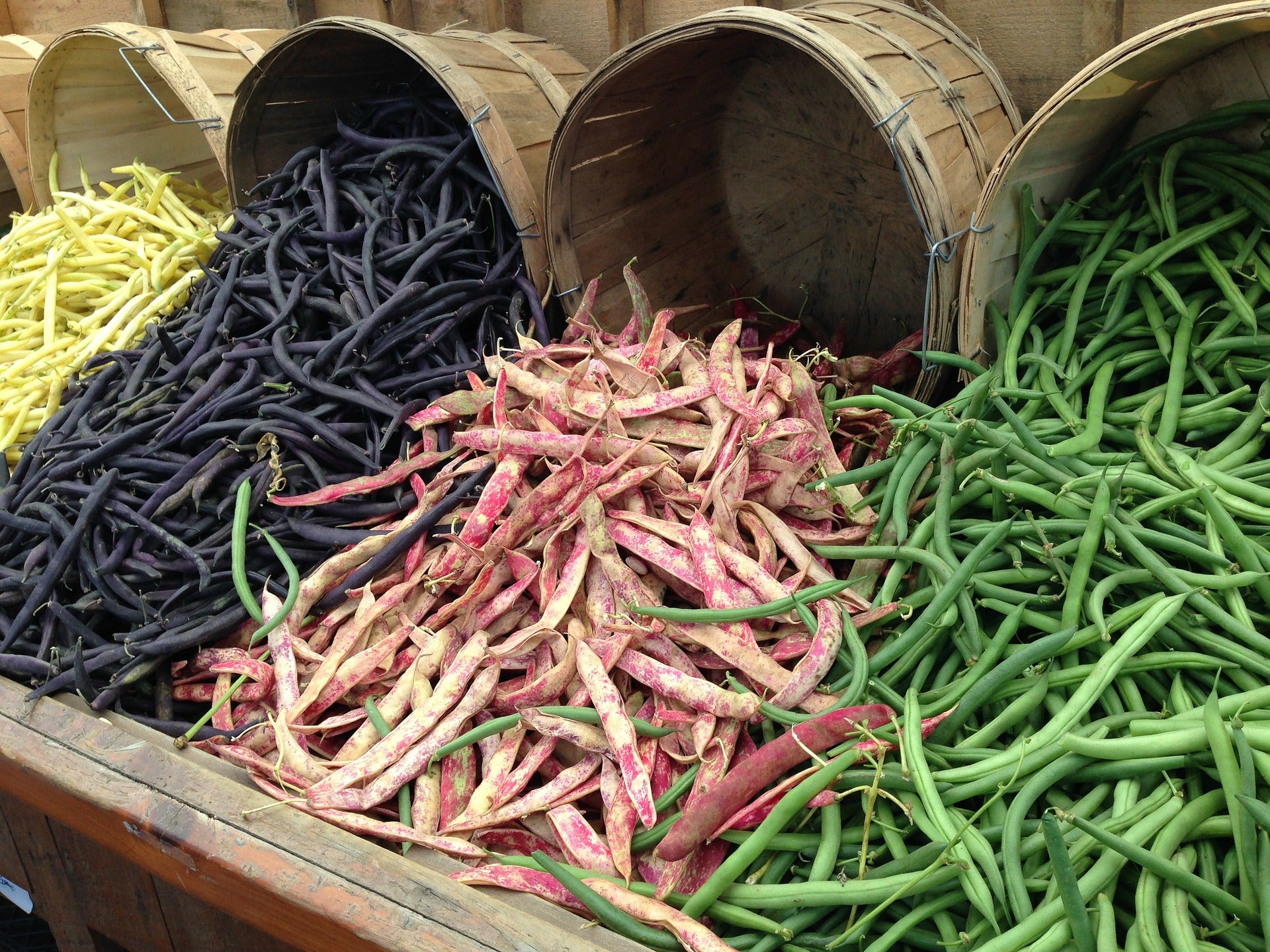
Today marks the first full day of spring, and with the change in season, you will have the opportunity for more outdoor workouts, later days and best of all -- spring foods. Each year between March and June, an abundance of fresh, light produce is available, providing new opportunities to ensure you are obtaining key nutrients.
These food items include asparagus, strawberries, spinach, artichokes and more. In this blog post, we list seven spring-time foods, along with the electrolyte benefits they provide. We also provide a few tips for incorporating them into your diet.
Produce is important! You may notice that magnesium often appears in the benefits listed below. Despite the mineral’s abundance in plant foods, more than
60 percent of adults in the U.S. do not consume enough magnesium in their diets. This is a bigger problem for endurance athletes
who need higher-than-normal levels of magnesium to help with recovery.
It is a good reminder of the importance to include a broad array of fruits and vegetables in your daily diet. As you can see below, magnesium and other electrolytes, such as calcium and potassium are found in many plants. By eating a balanced diet, you can help ensure you are setting yourself up to recover as quickly as possible.
Here are the electrolyte benefits of seven spring-time foods:
Asparagus:
With calcium, magnesium and potassium, asparagus packs a punch of electrolytes, not to mention high levels of Vitamin K, Vitamin A, folate and iron. Together, these nutrients
promote strong bones and a healthy cardiovascular system.
Enjoy asparagus steamed and added to a salad for additional plant-based sources of iron, or on top of your eggs in the morning, for a boost of Vitamin D. Asparagus is also great when grilled, perfect for your first barbecue as the weather heats up.
*Fun Fact: Prep and cooking time for asparagus is extremely minimal. The Romans, in love with its simplicity, coined the saying “As quick as cooking asparagus,” for something done rapidly.
Spinach:
Spinach has
trace elements of all four electrolytes, and it is a particularly good source of magnesium, with each serving providing 6 percent of your daily needs. Like asparagus, spinach is also high in Vitamin A, Vitamin K and folate.
This green superfood is beneficial to endurance athletes because it is high in antioxidants, which help repair damage resulting from large amounts of training. Additionally, the combination of Vitamin K and calcium helps keep bones strong, warding off the negative effects of pounding from high-impact sports such as running.
Spinach has a strong flavor, but it can be added to dishes in many ways. Use it as the base for a salad; combine it with fruit in a green smoothie; steam it as a side dish with butter; or mix it with eggs for a souffle, quiche or omelette.
*Fun Fact: In the 1930’s U.S. spinach growers credited Popeye with a 33 percent increase in domestic spinach consumption.
Beans:

A few years ago,
Runner’s World called beans a “powerhouse for runners,” due to the suite of nutritional benefits they provide. Legumes -- as beans are properly called -- are both a good source of complex carbohydrates and protein, which help the body rebuild itself during recovery from a hard workout or race.
Beans also pack in the fiber and phytonutrients, which help keep your digestive system functioning and repair any cell damage. In fact, three of the top five foods on
the USDA’s top-20 list for antioxidant capacity are beans. As for electrolytes, values differ depending on the type of bean you choose, but most species contain high amounts of magnesium and potassium.
Beans are popular in vegan and vegetarian diets because they provide large quantities of protein and other nutrients contained in meat and dairy products. They are also versatile: Eat beans by themselves as a side dish, or combine them with a grain (such as rice, quinoa or oats) for a complete spectrum of amino acids. Beans can also be added to salads, or crafted into a savory
burger.
*Fun Fact: The length of time from planting to harvesting green beans is only 45 to 60 days. Thus, green beans are among the most popular garden plants in the world.
Strawberries:

If you followed our
#30SaltyDays program in 2015, you already know about the electrolyte content of berries. Strawberries contain magnesium, calcium and potassium, along with huge amounts of Vitamin C. They are also fairly high in natural sugars, which makes them a good addition to a recovery shake or the perfect remedy to a craving for something sweet.
Enjoy strawberries plain, in Greek yogurt, in a smoothie, or on top of a spinach salad. If you like baking, strawberries also make scrumptious additions to cakes and breads, in the form of fruit toppings or as an ingredient in strawberry bread or pie.
*Fun Fact: Strawberries are the only fruit that contain seeds on the outside, meaning they are not technically berries. In reality, botanists consider each seed on a strawberry to be its own fruit.
Blueberries:
Like strawberries, blueberries contain high levels of potassium, Vitamin C and antioxidants, making them perfect for a post-workout meal or smoothie. Blueberries have been the subject of
many studies indicating their benefits to endurance athletes, including decreased recovery time and increased resistance to illness. For non-athletes,
blueberries have also been linked to anti-aging effects, healthier skin and decreased risk of heart disease and cancer.
Enjoy blueberries for breakfast on top of oatmeal with a dash of cinnamon, in a smoothie, or mixed into Greek yogurt. For a special treat, try this gluten-free “guilt-free” blueberry crisp from
Runner’s World.
*Fun Fact: Blueberries are one of the few popular fruits that are native to North America. Apples are native to Europe.
Artichokes:
Providing almost 15 percent of your daily magnesium needs per serving, artichokes are the way to go for keeping your electrolytes replenished. Artichokes are also high in potassium, Vitamin K and folate, which help keep your bones strong. Additionally, artichokes have some of the highest levels of antioxidants -- they are number seven on the
USDA’s top-20 list of antioxidant rich foods. As a result, artichokes have powerful detoxifying effects, making them a great hangover cure.
Artichokes are a bit tricky to prepare, but their savory hearts are worth the effort. Enjoy them in a homemade spinach-and-artichoke dip with some toasted pita bread, or grilled and covered in salted butter.
*Fun Fact: Ancient Greeks loved artichokes and used them for a variety of purposes, including an aphrodisiac, a diuretic, a breath freshener, and a deodorant.
Carrots:

Growing up, our parents told us carrots are good for the eyes, and they were right: A single serving of carrots provides more than 400 percent of your daily Vitamin A needs, which is very good for eye health, protecting the cornea and warding off macular degeneration and other eye-related diseases. Carrots are also full of Vitamin K and potassium.
More beta-carotene is
available in cooked carrots than raw carrots, so enjoy carrots lightly steamed and salted, or added to your favorite stew. However, if you are craving that loud “crunch” raw carrots make, baby carrots dipped in olive oil make a great afternoon snack.
*Fun Fact: Mel Blanc, the voice of cartoon character Bugs Bunny, reportedly did not like carrots.
Images from:
Pixabay.com

 Today marks the first full day of spring, and with the change in season, you will have the opportunity for more outdoor workouts, later days and best of all -- spring foods. Each year between March and June, an abundance of fresh, light produce is available, providing new opportunities to ensure you are obtaining key nutrients.
These food items include asparagus, strawberries, spinach, artichokes and more. In this blog post, we list seven spring-time foods, along with the electrolyte benefits they provide. We also provide a few tips for incorporating them into your diet.
Produce is important! You may notice that magnesium often appears in the benefits listed below. Despite the mineral’s abundance in plant foods, more than 60 percent of adults in the U.S. do not consume enough magnesium in their diets. This is a bigger problem for endurance athletes who need higher-than-normal levels of magnesium to help with recovery.
It is a good reminder of the importance to include a broad array of fruits and vegetables in your daily diet. As you can see below, magnesium and other electrolytes, such as calcium and potassium are found in many plants. By eating a balanced diet, you can help ensure you are setting yourself up to recover as quickly as possible.
Here are the electrolyte benefits of seven spring-time foods:
Today marks the first full day of spring, and with the change in season, you will have the opportunity for more outdoor workouts, later days and best of all -- spring foods. Each year between March and June, an abundance of fresh, light produce is available, providing new opportunities to ensure you are obtaining key nutrients.
These food items include asparagus, strawberries, spinach, artichokes and more. In this blog post, we list seven spring-time foods, along with the electrolyte benefits they provide. We also provide a few tips for incorporating them into your diet.
Produce is important! You may notice that magnesium often appears in the benefits listed below. Despite the mineral’s abundance in plant foods, more than 60 percent of adults in the U.S. do not consume enough magnesium in their diets. This is a bigger problem for endurance athletes who need higher-than-normal levels of magnesium to help with recovery.
It is a good reminder of the importance to include a broad array of fruits and vegetables in your daily diet. As you can see below, magnesium and other electrolytes, such as calcium and potassium are found in many plants. By eating a balanced diet, you can help ensure you are setting yourself up to recover as quickly as possible.
Here are the electrolyte benefits of seven spring-time foods:
 A few years ago, Runner’s World called beans a “powerhouse for runners,” due to the suite of nutritional benefits they provide. Legumes -- as beans are properly called -- are both a good source of complex carbohydrates and protein, which help the body rebuild itself during recovery from a hard workout or race.
Beans also pack in the fiber and phytonutrients, which help keep your digestive system functioning and repair any cell damage. In fact, three of the top five foods on the USDA’s top-20 list for antioxidant capacity are beans. As for electrolytes, values differ depending on the type of bean you choose, but most species contain high amounts of magnesium and potassium.
Beans are popular in vegan and vegetarian diets because they provide large quantities of protein and other nutrients contained in meat and dairy products. They are also versatile: Eat beans by themselves as a side dish, or combine them with a grain (such as rice, quinoa or oats) for a complete spectrum of amino acids. Beans can also be added to salads, or crafted into a savory burger.
*Fun Fact: The length of time from planting to harvesting green beans is only 45 to 60 days. Thus, green beans are among the most popular garden plants in the world.
A few years ago, Runner’s World called beans a “powerhouse for runners,” due to the suite of nutritional benefits they provide. Legumes -- as beans are properly called -- are both a good source of complex carbohydrates and protein, which help the body rebuild itself during recovery from a hard workout or race.
Beans also pack in the fiber and phytonutrients, which help keep your digestive system functioning and repair any cell damage. In fact, three of the top five foods on the USDA’s top-20 list for antioxidant capacity are beans. As for electrolytes, values differ depending on the type of bean you choose, but most species contain high amounts of magnesium and potassium.
Beans are popular in vegan and vegetarian diets because they provide large quantities of protein and other nutrients contained in meat and dairy products. They are also versatile: Eat beans by themselves as a side dish, or combine them with a grain (such as rice, quinoa or oats) for a complete spectrum of amino acids. Beans can also be added to salads, or crafted into a savory burger.
*Fun Fact: The length of time from planting to harvesting green beans is only 45 to 60 days. Thus, green beans are among the most popular garden plants in the world.
 If you followed our #30SaltyDays program in 2015, you already know about the electrolyte content of berries. Strawberries contain magnesium, calcium and potassium, along with huge amounts of Vitamin C. They are also fairly high in natural sugars, which makes them a good addition to a recovery shake or the perfect remedy to a craving for something sweet.
Enjoy strawberries plain, in Greek yogurt, in a smoothie, or on top of a spinach salad. If you like baking, strawberries also make scrumptious additions to cakes and breads, in the form of fruit toppings or as an ingredient in strawberry bread or pie.
*Fun Fact: Strawberries are the only fruit that contain seeds on the outside, meaning they are not technically berries. In reality, botanists consider each seed on a strawberry to be its own fruit.
If you followed our #30SaltyDays program in 2015, you already know about the electrolyte content of berries. Strawberries contain magnesium, calcium and potassium, along with huge amounts of Vitamin C. They are also fairly high in natural sugars, which makes them a good addition to a recovery shake or the perfect remedy to a craving for something sweet.
Enjoy strawberries plain, in Greek yogurt, in a smoothie, or on top of a spinach salad. If you like baking, strawberries also make scrumptious additions to cakes and breads, in the form of fruit toppings or as an ingredient in strawberry bread or pie.
*Fun Fact: Strawberries are the only fruit that contain seeds on the outside, meaning they are not technically berries. In reality, botanists consider each seed on a strawberry to be its own fruit.
 Growing up, our parents told us carrots are good for the eyes, and they were right: A single serving of carrots provides more than 400 percent of your daily Vitamin A needs, which is very good for eye health, protecting the cornea and warding off macular degeneration and other eye-related diseases. Carrots are also full of Vitamin K and potassium.
More beta-carotene is available in cooked carrots than raw carrots, so enjoy carrots lightly steamed and salted, or added to your favorite stew. However, if you are craving that loud “crunch” raw carrots make, baby carrots dipped in olive oil make a great afternoon snack.
*Fun Fact: Mel Blanc, the voice of cartoon character Bugs Bunny, reportedly did not like carrots.
Images from: Pixabay.com
Growing up, our parents told us carrots are good for the eyes, and they were right: A single serving of carrots provides more than 400 percent of your daily Vitamin A needs, which is very good for eye health, protecting the cornea and warding off macular degeneration and other eye-related diseases. Carrots are also full of Vitamin K and potassium.
More beta-carotene is available in cooked carrots than raw carrots, so enjoy carrots lightly steamed and salted, or added to your favorite stew. However, if you are craving that loud “crunch” raw carrots make, baby carrots dipped in olive oil make a great afternoon snack.
*Fun Fact: Mel Blanc, the voice of cartoon character Bugs Bunny, reportedly did not like carrots.
Images from: Pixabay.com








